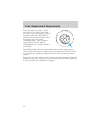
Emergency maneuvers
• In an unavoidable emergency situation where a sudden sharp turn
must be made, remember to avoid “over-driving” your vehicle, i.e.,
turn the steering wheel only as rapidly and as far as required to avoid
the emergency. Avoid abrupt steering, acceleration or braking which
could result in an increased risk of loss of vehicle control, vehicle
rollover, and/or personal injury. Additionally, smooth variations of the
accelerator and/or brake pedal pressure should be utilized if changes
in vehicle speed are called for. Avoid abrupt steering, acceleration or
braking. Use all available road surface to return the vehicle to a safe
direction of travel.
• In the event of an emergency stop, avoid skidding the tires and do not
attempt any sharp steering wheel movements.
• If the vehicle goes from one type of surface to another (i.e., from
concrete to gravel) there will be a change in the way the vehicle
responds to a maneuver (steering, acceleration or barking). Again,
avoid these abrupt inputs.
Snow and ice
Your 4WD or AWD vehicle will have advantages over two-wheel drive
vehicles in snow and on ice by providing increased driving traction.
However, if you suddenly change speed or direction you may lose
control. 4WD and AWD vehicles can slide on slippery roads just like any
other vehicle. Should you start to slide while driving on snowy or icy
roads, turn the steering wheel in the direction of the slide until you
regain control. Avoid sudden braking as well. Although a 4WD or AWD
vehicle may accelerate better than a two-wheel drive vehicle in snow and
ice, it won’t stop any faster, because as in other vehicles, braking occurs
at all four wheels. Do not become overconfident as to road conditions.
Make sure you allow sufficient distance between you and other vehicles
for stopping. In emergency stopping situations, avoid locking of the
wheels. Use a “squeeze” technique, push on the brake pedal with a
steadily increasing force which allows the wheels to brake yet continue
to roll so that you may steer in the direction you want to travel. If you
lock the wheels, release the brake pedal and repeat the squeeze
technique. If your vehicle has anti-lock brakes, apply the brake steadily.
Do not “pump” the brakes. See your “Owner’s Guide” for additional
information on the operation of the anti-lock brake system.
Operation On The Road
7


















